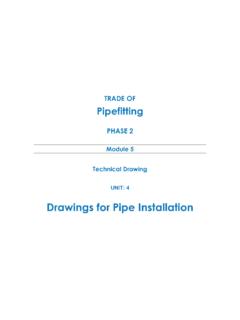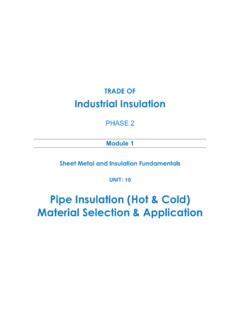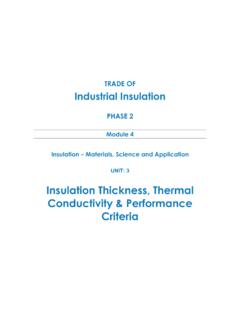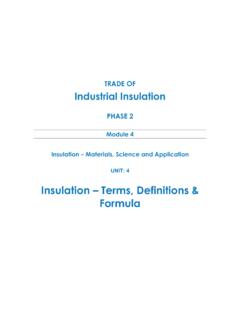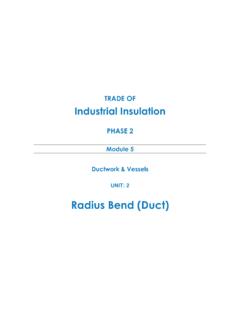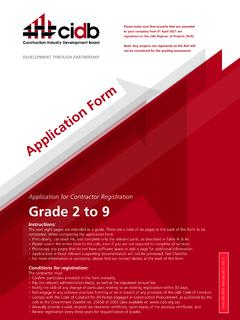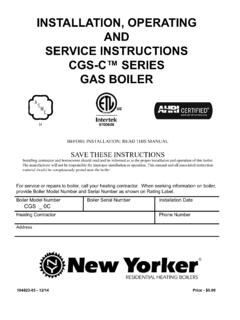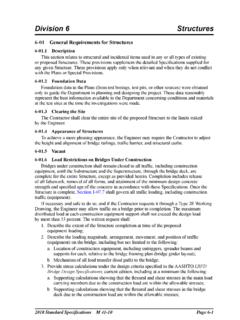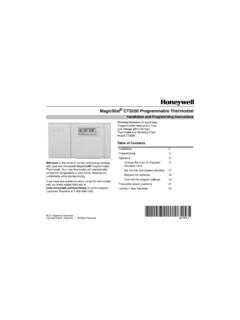Transcription of Module 4 Pipe Installation - eCollege
1 TRADE OF Pipefitting PHASE 2 Module 4 Pipe Installation UNIT: 1 Introduction to Pipe Installation and Safety Produced by In cooperation with subject matter expert: Finbar Smith SOLAS 2014 Module 4 Unit 1 Pipefitting Phase 2 Introduction to Pipe Installation & Safety Revision September 2014 Table of Contents Unit Objective .. 1 Learning Outcome .. 2 Pipe Installation on Site .. 3 Safety Concerns for On Site Work .. 3 Guidelines to Be Observed For Safe Site Work .. 4 Hazardous Activities Undertaken During Pipe Installation .. 5 Procedures for Drilling Building Structures .. 5 Procedures for Working in Excavations.
2 6 Using Permit to Work 7 Hazards Associated with Piping Systems .. 8 Hazards Associated with Piping Services .. 8 Colour Coding for Piping Systems .. 9 MSDS Sheets .. 11 Tying Into a Live Piping System .. 13 Safety at Heights and in Confined Spaces .. 15 Working at Heights .. 15 Equipment Used for Working at Heights .. 16 Correct Use of a Personal Safety Harness .. 21 Identifying Confined Spaces and Their Hazards .. 23 Working in Confined Spaces .. 24 Exercises .. 26 Additional Resources .. 27 Module 4 Unit 1 Introduction to Pipe Installation and Safety Pipefitting Phase 2 1 Revision September 2014 Unit Objective There are six Units in Module 4.
3 Unit 1 focuses on Introduction to Pipe Installation and Safety, Unit 2; Piping Services, Unit 3; Electricity on Site, Unit 4; Bracket Fabrication, Unit 5; Ancillary Piping Equipment and Unit 6; Piping system assembly. In this unit you will be introduced to pipe Installation on site and the safety precautions required when completing this type of work. Important Note The following unit cannot be used as a substitute for formal safety training. Candidates must complete formal SafePass training as well as certified training and instruction for the use of specific MEWP equipment, safety equipment and confined spaces training for working in hazardous areas, as required by their employer and the laws of this land.
4 Module 4 Pipe InstallationUnit 1 Introduction to Pipe Installation and Safety Unit 2 Piping Services Unit 3 Electricity on Site Unit 4 Bracket FabricationUnit 5 Ancillary Piping Equipment Unit 6 Piping System AssemblyModule 4 Unit 1 Introduction to Pipe Installation and Safety Pipefitting Phase 2 2 Revision September 2014 Learning Outcome By the end of this unit each apprentice will be able to: Describe the key safety concerns associated with pipe installations on a site as opposed to working in the controlled environment of a workshop. List the activities of pipe Installation for over ground, underground, high pressure and low pressure piping systems.
5 Describe the potential hazards associated with drilling and excavating wall and floors with respect to buried or concealed services Identify the key requirements for permit to work forms and how to fill out a generic work permit form. Describe the hazards associated with the following piping systems, steam , compressed gases, water, chemicals, solvents and fuel oil. Describe how colour coding systems are used to identify the contents of live piping systems. Describe the purpose of Material Safety Data Sheets (MSDS) and how they provide procedures for handling or working with that substance in a safe manner. Describe the key safety concerns with tying into a live piping system Describe the different types of equipment for working at heights, state their applications and describe their limitations.
6 Demonstrate how to fit a safety harness and lanyard and list the pre-use safety checks to be performed before using one. Describe the potential hazards associated when working in confined spaces or in deep excavations and what precautions must be taken Module 4 Unit 1 Introduction to Pipe Installation and Safety Pipefitting Phase 2 3 Revision September 2014 Pipe Installation on Site Safety Concerns for On Site Work Construction sites are among the most dangerous and risky working environments. Building infrastructure involves a wide array of processes, along with potentially hazardous materials and equipment, so employers have to impose construction-site safety rules in an attempt to keep accidents and mishaps from taking place.
7 While standard safe working practices and rules still apply, working on sites exposes the individual to a complete new set of risks and hazards which are not experienced in a controlled workshop environment. Some general principals to be observed when organising work on site can be stated as follows: The work must be designed in such a way that any risk to life and health is avoided as far as possible and the remaining danger is minimized. Dangers must be combated at source and risks eliminated. PPE should only be used as a second line of defence. Suitable instructions and training must be given to all employees and visitors to sites.
8 At all times the employer and the employee should strive to ensure that state of the art occupational medicine and hygiene and other sound knowledge according to the relevant codes of practice are taken into account. Work should be planed and provide with an appropriate link between available technology, work organization, other working trades and working conditions that influence the environment of the workplace. Individual protective measures should take second priority to the safety of the collective group. Key Learning Points Identify the different safety concerns when working on sites compared to working in a controlled workshop environment. Identify safe guidelines when working on site Identify typical activities completed when installing pipe work on site Identify the hazards associated with drilling or excavating and how to minimize them Module 4 Unit 1 Introduction to Pipe Installation and Safety Pipefitting Phase 2 4 Revision September 2014 Guidelines to Be Observed For Safe Site Work The following are basic precautions to be observed when working on construction sites.
9 (Please note that this is not an exhaustive list and consultation with the Site safety officer is critical before any work should commence): Be aware that a construction site is a changing environment and that new hazards are appearing and changing all the time. Pipe fitters should complete site inductions to be aware of prevailing site conditions before commencing any work Obey permit to work systems as site conditions may change from day to day The primary goal should be to eliminate the risk rather than protect against it. Correct PPE equipment should be worn, however this should be the second line of defence. Be aware of site traffic, machinery and equipment.
10 Make eye contact with the driver and wait for a signal that is OK to proceed in mobile plants pathway. Be aware of the other trades working on site as these will have different goals to be achieved which will sometimes conflict with your goals. Be aware when working at heights and take appropriate safety precautions. Be aware when working in excavations and take appropriate safety precautions. Be aware when working in confined spaces and take appropriate safety precautions. Report all incidents / accidents no matter how minor so that other people can learn from the experience and hopefully not repeat the same mistake. Obey all safety signage and never assume that you know better.
